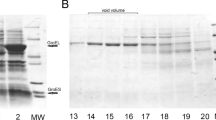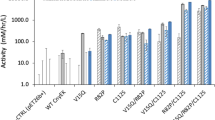Abstract
Expression of two diphtheria toxin gene fragments in E. coli was studied as a means of obtaining large quantities of proteins for use in immunotoxins. Removal of the secretory leader, and replacement of the diphtheria toxin promoter and Shine–Dalgarno sequence increased the levels of expression in E. coli 36– to 216–fold. We were able to produce the DTA–like peptide at 5 to 7% of the total cell protein. The high level of expression of these proteins in E. coli will facilitate further modification for producing more efficacious effector moieties for use in immunoconjugates.
This is a preview of subscription content, access via your institution
Access options
Subscribe to this journal
Receive 12 print issues and online access
$209.00 per year
only $17.42 per issue
Buy this article
- Purchase on Springer Link
- Instant access to full article PDF
Prices may be subject to local taxes which are calculated during checkout
Similar content being viewed by others
References
Yamaizumi, M., Mekada, E., Uchida, T., and Okada, Y. 1978. One molecule of diphtheria toxin fragment A introduced into a cell can kill the cell. Cell 15:245–250.
Chang, T.-M., and Neville, Jr., D.M. 1977. Artificial hybrid protein containing a toxic protein fragment and a cell membrane receptor-binding moiety in a disulfide conjugate. I. Synthesis of diphtheria toxin fragment A-S-S-human placental lactogen with methyl-5-bromo-valerimidate. J. Biol. Chem. 252:1505–1514.
Gilliland, D.G., Collier, R.J., Moehring, J.M., and Moehring, T.J. 1978. Chimeric toxins: Toxic, disulfide-linked conjugate of concanavalin A with fragment A from diphtheria toxin. Proc. Natl. Acad. Sci. USA 75:5319–5323.
Gilliland, D.G., Steplewski, Z., Collier, R.J., Mitchell, K.F., Chang, T.H., and Koprowski, H. 1980. Antibody-directed cytotoxic agents:Use of monoclonal antibody to direct the action of toxin A chains to colorectal carcinoma cells. Proc. Natl. Acad. Sci. USA 77:4539–4543.
Bumol, T.F., Wang, Q.C., Reisfeld, R.A., and Kaplan, N.O. 1983. Monoclonal antibody and an antibody-toxin conjugate to a cell surface proteoglycan of melanoma cells suppress in vivo tumor growth. Proc. Natl. Acad. Sci. USA 80:529–533.
Cawley, D.B., Herschman, H.R., Gilliland, D.G., and Collier, R.J. 1980. Epidermal growth factor-toxin A chain conjugates: EGF-ricin A is a potent toxin while EGF-diphtheria fragment A is nontoxic. Cell 22:563–570.
Chang, T.-M., Dazord, A., and Neville, Jr., D.M. 1977. Artificial hybrid protein containing a toxic protein fragment and a cell membrane receptor-binding moiety in a disulfide conjugate. II. Biochemical and biologic properties of diphtheria toxin fragment A-S-S-human placental lactogen. J. Biol. Chem. 252:1515–1522.
Simpson, D.L., Cawley, D.B., and Herschman, H.R. 1982. Killing of cultured hepatocytes by conjugates of asialofetuin and EGF linked to the A chains of ricin or diphtheria toxin. Cell 29:469–473.
Uchida, T., Pappenheimer, Jr., A.M., and Greany, R. 1973. Diphtheria toxin and related proteins. J. Biol. Chem. 248:3838–3844.
Kagan, B.L., Finkelstein, A., and Colombini, M. 1981. Diphtheria toxin fragment forms large pores in phospholipid bilayer membranes. Proc. Natl. Acad. Sci. USA 78:4950–4954.
Donovan, J.J., Simon, M.I., Draper, R.K., and Montal, M. 1981. Diphtheria toxin forms transmembrane channels in planar lipid bilayers. Proc. Natl. Acad. Sci. USA 78:172–176.
Boquet, P. 1977. Transport of diphtheria toxin fragment A across mammalian cell membranes. Biochem. Biophys. Res. Commun. 75:696–702.
Bacha, P., Murphy, J.R. and Reichlin, S. 1983. Thyrotropin-releasing hormone-diphtheria toxin-related polypeptide conjugates. J. Biol. Chem. 258:1565–1570.
Greenfield, L., Bjorn, M.J., Horn, G., Fong, D., Buck, G.A., Collier, R.J., and Kaplan, D. 1983. Nucleotide sequence of the structural gene for diphtheria toxin carried by corynebacteriophage β. Proc. Natl. Acad. Sci. USA 80:6853–6857.
Tweten, R.K. and Collier, R.J. 1983. Molecular cloning and expression of gene fragments from corynebacteriophage β encoding enzymatically active peptides of diphtheria toxin. J. Bacteriol. 156:680–685.
Kaczorek, M., Delpeyroux, F., Chenciner, N., Streeck, R.E., Murphy, J.R., Boquet, P., and Tiollais, P. 1983. Nucleotide sequence and expression of the diphtheria tox228 gene in Escherichia coli. Science 221:855–858.
Leong, D., Coleman, K.D., and Murphy, J.R. 1983. Cloned fragment A of diphtheria toxin is expressed and secreted into the periplasmic space of Escherichia coli K12. Science 220:515–517.
Kaczorek, M., Zettlmeissl, G., Delpeyroux, F., and Streeck, R.E. 1985. Diphtheria toxin promoter function in Corynebacterium diphtheriae and Escherichia coli. Nucl. Acids Res. 13:3147–3159.
Giannini, G., Rappuoli, R., and Ratti, G. 1984. The amino-acid sequence of two nontoxic mutants of diphtheria toxin: CRM45 and CRM197. Nucl. Acids Res. 12:4063–4069.
Leong, D., Coleman, K.D., and Murphy, J.R. 1983. Cloned diphtheria toxin fragment A is expressed from the tox promoter and exported to the periplasm by the SecA apparatus of Escherichia coli K12. J. Biol. Chem. 258:15016–15020.
Roth, M.J., Tanese, N., and Goff, S.P. 1985. Purification and characterization of murine retroviral reverse transcriptase expressed in Escherichia coli. J. Biol. Chem. 260:9326–9335.
Casadaban, M.J., and Cohen, S.N. 1980. Analysis of gene control signals by DNA fusion and cloning in Escherichia coli. J. Mol. Biol. 138:179–207.
Meselson, M. and Yuan, R. 1968. DNA restriction enzyme from E. coli. Nature 217:1110–1114.
Boyer, H.W., Betlach, M., Bolivar, F., Rodriguez, R.L., Heyneker, H.L., Shine, J., and Goodman, H.M. 1977. The construction of molecular cloning vehicles, p. 9–20. In: R. F, Beers, Jr. and E. G. Bassett (eds.), Recombinant Molecules: Impact on Science and Society. Raven Press, New York.
Miller, J.H. 1972. Experiments in Molecular Genetics, Cold Spring Harbor Laboratory, Cold Spring Harbor, New York.
Rosenberg, S.A., Grimm, E.A., McGrogan, M., Doyle, M., Kawasaki, E., Koths, K., and Mark, D.F. 1984. Biological activity of recombinant human interleukin-2 produced in Escherichia coli. Science 223:1412–1415.
Clewell, D.B. and Helinski, D.R. 1969. Supercoiled circular DNA-protein complex in Escherichia coli: Purification and induced conversion to an open circular DNA form. Proc. Natl. Acad. Sci. USA 62:1159–1166.
Maxam, A.M. and Gilbert, W. 1980. Sequencing end-labeled DNA with base-specific chemical cleavages. Methods Enzymol. 65:499–560.
Birnboim, H.C. and Doly, J. 1979. A rapid alkaline extraction procedure for screening recombinant plasmid DNA. Nucl. Acids Res. 7:1513–1523.
Bjorn, M.J., Kaplan, D.A., and Collier, R.J. 1983. Identification of DNA restriction fragments of corynebacteriophage β corresponding to hypotoxic peptides of diphtheria toxin. FEMS Microbiology Letters 20:177–180.
Sutcliffe, J.G. 1970. Complete nucleotide sequence of the Escherichia coli plasmid pBR322. Cold Spring Harbor Symp. Quant. Biol. 43:77–90.
Horn, G.T. and Wells, R.D. 1981. The leftward promoter of bacteriophage λ. J. Biol. Chem. 256:1998–2002.
DeLange, R.J., Drazin, R.E., and Collier, R.J. 1976. Amino-acid sequence of fragment A, an enzymically active fragment from diphtheria toxin. Proc. Natl. Acad. Sci. 73:69–72.
Sanger, F., Coulson, A.R., Hong, G.F., Hill, D.F., and Petersen, G.B. 1982. Nucleotide sequence of bacteriophage λ DNA. J. Mol. Biol. 162:729–773.
Gelfand, D.H., Shepard, H.M., O'Farrell, P.H., and Polisky, B. 1978. Isolation and characterization of a ColEl-derived plasmid copy-number mutant. Proc. Natl. Acad. Sci. USA 75:5869–5873.
Muesing, M., Tamm, J., Shepard, H.M., and Polisky, B. 1981. A single base-pair alteration is responsible for the DNA overproduction phenotype of a plasmid copy-number mutant. Cell 45:235–242.
Heffron, F. and McCarthy, B.J. 1979. DNA sequence analysis of the transposon Tn3: Three genes and three sites involved in transposition of Tn3. Cell 18:1153–1163.
Wong, E.M., Muesing, M.A. and Polisky, B. 1982. Temperature-sensitive copy number mutants of ColEl are located in an untranslated region of the plasmid genome. Proc. Natl. Acad. Sci. USA 79:3570–3574.
Polisky, B., Bishop, R.J., and Gelfand, D.H. 1976. A plasmid cloning vehicle allowing regulated expression of eukaryotic DNA in bacteria. Proc. Natl. Acad. Sci. USA 72:3900–3904.
Laemmli, U.K. 1970. Cleavage of structural proteins during the assembly of the head of bacteriophage T4. Nature 227:680–685.
Chung, D.W. and Collier, R.J. 1977. Enzymatically active peptide from the adenosine diphosphate-ribosylating toxin of Pseudomonas aeruginosa. Infect. Immun. 16:832–841.
Towbin, H., Staehelin, T., and Gordon, J. 1979. Electrophoretic transfer of proteins from polyacrylamide gels to nitrocellulose sheets: procedure and some applications. Proc. Natl. Acad. Sci. USA 76:4350–4354.
Author information
Authors and Affiliations
Rights and permissions
About this article
Cite this article
Greenfield, L., Dovey, H., Lawyer, F. et al. High–Level Expression of Diphtheria Toxin Peptides in Escherichia coli. Nat Biotechnol 4, 1006–1011 (1986). https://doi.org/10.1038/nbt1186-1006
Received:
Accepted:
Issue Date:
DOI: https://doi.org/10.1038/nbt1186-1006
This article is cited by
-
Site-Directed Pegylation of Recombinant Interleukin-2 at its Glycosylation Site
Nature Biotechnology (1990)



